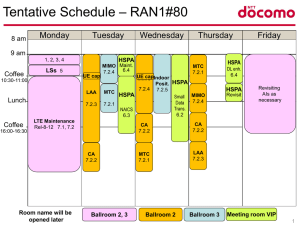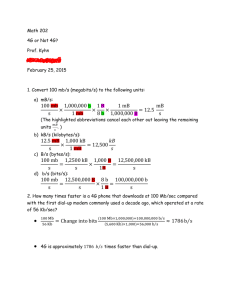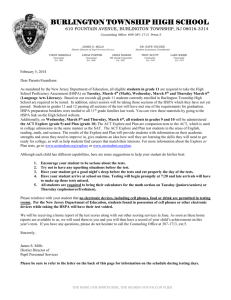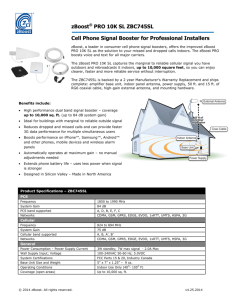High Speed Packet Access Mr. Santosh G. Bari
advertisement
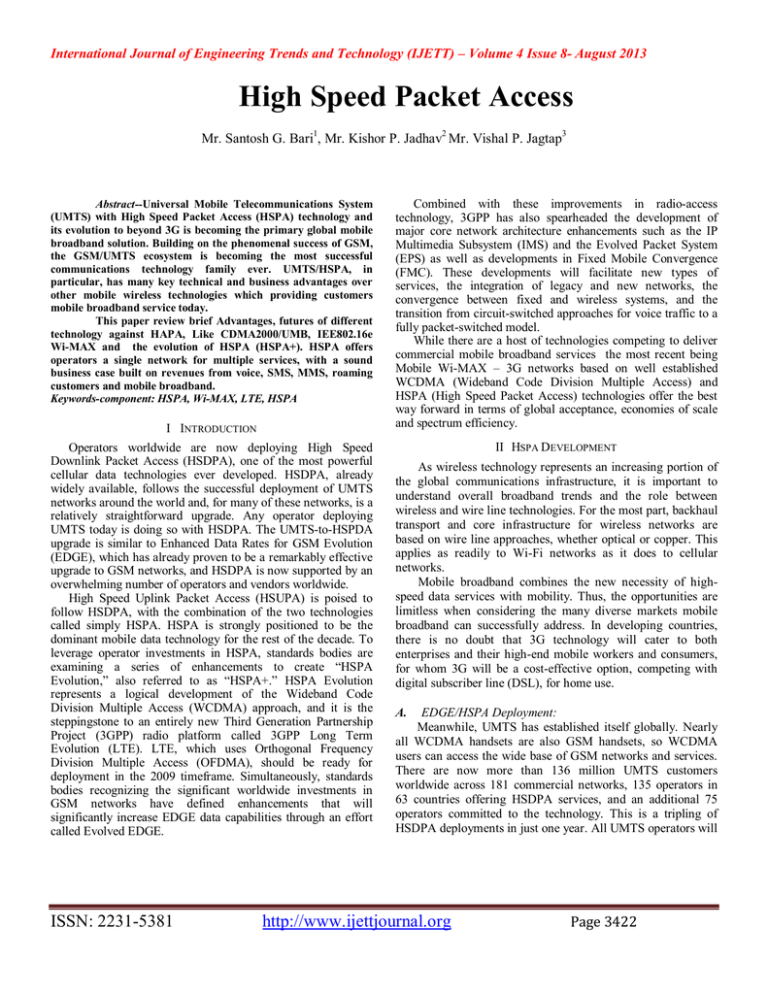
International Journal of Engineering Trends and Technology (IJETT) – Volume 4 Issue 8- August 2013 High Speed Packet Access Mr. Santosh G. Bari1, Mr. Kishor P. Jadhav2 Mr. Vishal P. Jagtap3 Abstract--Universal Mobile Telecommunications System (UMTS) with High Speed Packet Access (HSPA) technology and its evolution to beyond 3G is becoming the primary global mobile broadband solution. Building on the phenomenal success of GSM, the GSM/UMTS ecosystem is becoming the most successful communications technology family ever. UMTS/HSPA, in particular, has many key technical and business advantages over other mobile wireless technologies which providing customers mobile broadband service today. This paper review brief Advantages, futures of different technology against HAPA, Like CDMA2000/UMB, IEE802.16e Wi-MAX and the evolution of HSPA (HSPA+). HSPA offers operators a single network for multiple services, with a sound business case built on revenues from voice, SMS, MMS, roaming customers and mobile broadband. Keywords-component: HSPA, Wi-MAX, LTE, HSPA I INTRODUCTION Operators worldwide are now deploying High Speed Downlink Packet Access (HSDPA), one of the most powerful cellular data technologies ever developed. HSDPA, already widely available, follows the successful deployment of UMTS networks around the world and, for many of these networks, is a relatively straightforward upgrade. Any operator deploying UMTS today is doing so with HSDPA. The UMTS-to-HSPDA upgrade is similar to Enhanced Data Rates for GSM Evolution (EDGE), which has already proven to be a remarkably effective upgrade to GSM networks, and HSDPA is now supported by an overwhelming number of operators and vendors worldwide. High Speed Uplink Packet Access (HSUPA) is poised to follow HSDPA, with the combination of the two technologies called simply HSPA. HSPA is strongly positioned to be the dominant mobile data technology for the rest of the decade. To leverage operator investments in HSPA, standards bodies are examining a series of enhancements to create “HSPA Evolution,” also referred to as “HSPA+.” HSPA Evolution represents a logical development of the Wideband Code Division Multiple Access (WCDMA) approach, and it is the steppingstone to an entirely new Third Generation Partnership Project (3GPP) radio platform called 3GPP Long Term Evolution (LTE). LTE, which uses Orthogonal Frequency Division Multiple Access (OFDMA), should be ready for deployment in the 2009 timeframe. Simultaneously, standards bodies recognizing the significant worldwide investments in GSM networks have defined enhancements that will significantly increase EDGE data capabilities through an effort called Evolved EDGE. ISSN: 2231-5381 Combined with these improvements in radio-access technology, 3GPP has also spearheaded the development of major core network architecture enhancements such as the IP Multimedia Subsystem (IMS) and the Evolved Packet System (EPS) as well as developments in Fixed Mobile Convergence (FMC). These developments will facilitate new types of services, the integration of legacy and new networks, the convergence between fixed and wireless systems, and the transition from circuit-switched approaches for voice traffic to a fully packet-switched model. While there are a host of technologies competing to deliver commercial mobile broadband services the most recent being Mobile Wi-MAX – 3G networks based on well established WCDMA (Wideband Code Division Multiple Access) and HSPA (High Speed Packet Access) technologies offer the best way forward in terms of global acceptance, economies of scale and spectrum efficiency. II HSPA DEVELOPMENT As wireless technology represents an increasing portion of the global communications infrastructure, it is important to understand overall broadband trends and the role between wireless and wire line technologies. For the most part, backhaul transport and core infrastructure for wireless networks are based on wire line approaches, whether optical or copper. This applies as readily to Wi-Fi networks as it does to cellular networks. Mobile broadband combines the new necessity of highspeed data services with mobility. Thus, the opportunities are limitless when considering the many diverse markets mobile broadband can successfully address. In developing countries, there is no doubt that 3G technology will cater to both enterprises and their high-end mobile workers and consumers, for whom 3G will be a cost-effective option, competing with digital subscriber line (DSL), for home use. A. EDGE/HSPA Deployment: Meanwhile, UMTS has established itself globally. Nearly all WCDMA handsets are also GSM handsets, so WCDMA users can access the wide base of GSM networks and services. There are now more than 136 million UMTS customers worldwide across 181 commercial networks, 135 operators in 63 countries offering HSDPA services, and an additional 75 operators committed to the technology. This is a tripling of HSDPA deployments in just one year. All UMTS operators will http://www.ijettjournal.org Page 3422 International Journal of Engineering Trends and Technology (IJETT) – Volume 4 Issue 8- August 2013 deploy HSDPA for two main reasons: the incremental cost of HSDPA is relatively low, and HSDPA makes such efficient use of spectrum for data that it results in a much lower overall cost per megabyte of data delivered. Already, there are over 300 commercial HSDPA devices available worldwide, and this number is quickly growing. B. Wireless Technology Evolution and Migration: The Evolution and Migration of wireless-data technologies from EDGE to LTE as well as the evolution of underlying wireless approaches. Progress happens in multiple phases, first with EDGE, and then UMTS, followed by evolved 3G capabilities such as HSDPA, HSUPA, HSPA+, and eventually LTE. Meanwhile, underlying approaches have evolved from Time Division Multiple Access (TDMA) to CDMA, and now from CDMA to OFDMA, which is the basis of LTE. HSPA carriers). In recent years, the ability of OFDM to cope with multipath has also made it the technology of choice for the design of Digital Broadcast Systems. In 5 MHz of spectrum, as used by UMTS/HSPA, continual advances with CDMA technology realized in HSPA+ through approaches such as equalization, MIMO, interference cancellation, and high-order modulation will allow CDMA to largely match OFDMA-based systems. TABLE I SUMMARY OF DIFFERENT WIRELESS APPROACHES Approach Technologies Employing Approach Comments TDMA GSM,GPRS,EDGE,Tele communication Industry Associations/Electronics Industry Association (TIA/EIA)-136 TDMA First digital cellular approach, Hugely Successful with GSM. New enhancements being designed for GSM/EDGC. CDMA CDMA2000 1×RTT, CDMA2000 EV-DO, WC-DO, WCDMA, HSPA, Institute of Electrical and Electronics Engineers (IEEE) 802.11b Basic for nearly all new 3G networks. Mature, efficient, and will dominate wide-area wireless systems for the remainder of this decade. OFDM/ OFDMA 802.16/WiMAX, Flarion Fast Low-Latency Access with Seamless Handoff OFDM (Flash OFDM),3GPP LTE, IEEE 802.11a,IEEE 802.11g, IEEE 802.20 Third Generation Partnership Project 2 (3GPP2) UMB, 3GPP2 Effective approach for broadcast systems, higher bandwidth radio systems, and high peak data rates in large blocks of spectrum. Also provides flexibility in the amount of spectrum used. Well suited for systems planned for the next decade Figure 1: Evolution of TDMA, CDMA, and OFDM Systems a. Technical Approaches (TDMA, CDMA, OFDMA): Considerable discussion in the wireless industry has focused on the relative benefits of TDMA, CDMA, and, more recently, OFDMA. Many times, one technology or the other is positioned as having fundamental advantages over another. However, any of these three approaches, when fully optimized, can effectively match the capabilities of any other. GSM, which is based on TDMA, is a case in point. Through innovations like frequency hopping, the Adaptive Multi Rate (AMR) vocoder for voice, and EDGE for data performance optimization, GSM is able to effectively compete with the capacity and data throughput of CDMA2000 One Carrier Radio Transmission Technology (1xRTT). An OFDMA technology such as LTE can also take better advantage of wider radio channels (for example, 10 MHz) by not requiring guard bands between radio carriers (for example, ISSN: 2231-5381 b. 3GPP Evolutionary Approach: Rather than emphasizing any one wireless approach, 3GPP’s evolutionary plan is to recognize the strengths and weaknesses of every technology and to exploit the unique capabilities of each one accordingly. GSM, based on a TDMA approach, is mature and broadly deployed. Already extremely efficient, there are nevertheless opportunities for additional optimizations and enhancements. Standards bodies have already defined “Evolved EDGE,” which will be available in the 2008 timeframe and bring more than a doubling of performance over current EDGE systems. By the end of the decade, because of sheer market momentum, the majority of worldwide subscribers will still be using GSM/EDGE technologies. The evolved data systems for UMTS, such as HSPA and HSPA+, introduce enhancements and simplifications that help CDMA based systems match the http://www.ijettjournal.org Page 3423 International Journal of Engineering Trends and Technology (IJETT) – Volume 4 Issue 8- August 2013 capabilities of competing systems, especially in 5 MHz spectrum allocations. C. UMTS/HSPA TECHNOLOGY UMTS has garnered the overwhelming majority of new 3G spectrum licenses, with 177 commercial networks already in operation. Compared to emerging wireless technologies, UMTS technology is mature and benefits from research and development that began in the early 1990s. It has been thoroughly trialed, tested, and commercially deployed. UMTS deployment is now accelerating with stable network infrastructures and attractive, reliable mobile devices that have rich capabilities. With the addition of HSPA for high speed packet data services, UMTS/HSPA is quickly emerging as the dominant global mobile-broadband network. broadband services, and it has the highest theoretical peak throughput of any cellular technology currently available. The higher spectral efficiency and higher data rates not only enable new classes of applications but also support a greater number of users accessing the network. HSDPA achieves its performance gains from the following radio features: a. High-Speed Shared Channels and Short Transmission Time Interval: First HSDPA uses high-speed data channels called High Speed Physical Downlink Shared Channels (HSPDSCH). Up to 15 of these channels can operate in the 5 MHz WCDMA radio channel. b. D. HSDPA HSDPA is a tremendous performance upgrade for packet data that delivers peak theoretical rates of 14 Mbps. Peak user-achievable throughput rates in initial deployments are well over 1 Mbps, often reaching 1.5 Mbps—three to five times faster than Release 99 data—and will increase over time with enhanced terminals and network capabilities. Specified as part of 3GPP Release 5, operators are now deploying HSDPA around the world. In the United States, AT&T has HSDPA service in all major markets and TMobile is planning to deploy it in its recently acquired 1.7/2.1 GHz spectrum. HSDPA is gaining traction in Latin America, with deployments by Personal and Movistar in Argentina, Movistar in Mexico and Uruguay, Ancel in Uruguay, AT&T in Puerto Rico, and Entel PCS in Chile. By the end of 2008, HSDPA is expected to be widely deployed throughout Latin America. HSDPA is fully backwardcompatible with UMTS Release 99, and any application developed for Release 99 will work with HSDPA. The same radio carrier can simultaneously service UMTS voice and data users as well as HSDPA data users. HSDPA also has significantly lower latency, measured today on some networks as low as 70 msec on the data channel. HSDPA achieves its high speeds through techniques similar to those that push EDGE performance past GPRS, including higher order modulation, variable coding, and soft combining, as well as through the addition of powerful new techniques such as fast scheduling. HSDPA elevates the performance level of WCDMA technology to provide ISSN: 2231-5381 Fast Scheduling and User Diversity: Fast scheduling exploits the short TTI by assigning users channels that have the best instantaneous channel conditions rather than in a round-robin fashion. FIGURE2 shows how a sched uler might choos e betwe en two users based on their varyi ng radio conditions to emphasize the user with better instantaneous signal quality. Figure2: user diversity c. Higher Order Modulation: HSDPA uses both the modulation used in WCDMA namely QPSK—and, under good radio conditions, an advanced modulation scheme—16 QAM. Data throughput is increased with 16 QAM, while QPSK is available under adverse conditions. HSPA Evolution will add 64 QAM modulation to further increase throughput rates. d. Fast Link Adaptation: Depending on the condition of the radio channel, different levels of forward-error correction (channel coding) can also be employed. e. Fast Hybrid Automatic Repeat Request: Another HSDPA technique is Fast Hybrid Automatic Repeat Request (Fast Hybrid ARQ). “Fast” refers to the medium-access control mechanisms implemented in Node B http://www.ijettjournal.org Page 3424 International Journal of Engineering Trends and Technology (IJETT) – Volume 4 Issue 8- August 2013 (along with scheduling and link adaptation), as opposed to the BSC in GPRS/EDGE, and “hybrid” refers to a process of combining repeated data transmissions with prior transmissions to increase the likelihood of successful decoding. E. HSUPA Whereas HSDPA optimizes downlink performance, HSUPA—which uses the Enhanced Dedicated Channel (EDCH)—constitutes a set of improvements that optimizes uplink performance. Networks and devices supporting HSUPA became available in 2007. These improvements include higher throughputs, reduced latency, and increased spectral efficiency. HSUPA is standardized in Release 6. It will result in an approximately 85 percent increase in overall cell throughput on the uplink and more than 50 percent gain in user throughput. HSUPA also reduces packet delays. Although the primary downlink traffic channel supporting HSDPA serves is a shared channel designed for the support of services delivered through the packet-switched domain, the primary uplink traffic channel defined for HSUPA is a dedicated channel that could be used for services delivered through either the circuit-switched or the packet switched domains. Nevertheless, by extension and for simplicity, the WCDMA-enhanced uplink capabilities are often identified in the literature as HSUPA. Such an improved uplink will benefit users in a number of ways. For instance, some user applications transmit large amounts of data from the mobile station, such as sending video clips or large presentation files. For future applications like VoIP, improvements will balance the capacity of the uplink with the capacity of the downlink. HSUPA achieves its performance gains through the following approaches: An enhanced dedicated physical channel A short TTI, as low as 2 msec, which allows faster responses to changing radio conditions and error conditions Fast Node B-based scheduling, which allows the base station to efficiently allocate radio resources Fast Hybrid ARQ, which improves the efficiency of error processing The combination of TTI, fast scheduling, and Fast Hybrid ARQ also serves to reduce latency, which can benefit many applications as much as improved throughput. HSUPA can operate with or without HSDPA in the downlink, though it is likely that most networks will use the two approaches together. The improved uplink mechanisms also translate to better coverage and, for rural deployments, larger cell sizes. III. Comparing radio technologies is never a straightforward undertaking. Every technology has its own unique characteristics and implementation, which means an ‘appleswith-apples’ comparison is not easy. HSPA and Mobile WiMAX are designed for high-speed packet data services and share many similar technology enablers. However, there are differences that lead to differences in the uplink bit-rates, architecture and coverage they provide. A. Peak Data Rate and Spectral Efficiency: Theoretically, it is possible to calculate the upper limits of performance that HSPA and Mobile WiMAX can achieve. The key performance data for each technology are summarized in figure3.Figure3 Overview of HSPA and Mobile Wi-Max Performance The overall complexity of the different network architectures is very similar which is not surprising as the goal is to deliver the same functionality (as can be seen in figure 4). HSPA AND MOBILE WIMAX ISSN: 2231-5381 http://www.ijettjournal.org Page 3425 International Journal of Engineering Trends and Technology (IJETT) – Volume 4 Issue 8- August 2013 Figure 4: Overview of network architecture for HSPA and Mobile WiMAX B. COVERAGE HSPA is a Frequency Division Duplex (FDD) technology, in which the uplink and downlink are in separate frequency channels (usually denoted as 2x5MHz). Mobile WiMAX is a Time Division Duplex (TDD) technology, in which there is just one frequency channel that is shared between the uplink and the downlink. The ratio between the uplink and the downlink defines how they share the frequency channel in time. A 1:1 ratio indicates time split 50/50 between the uplink and the downlink as outlined in figure 5 Figure 7: Example deployment for HSPA and Mobile WiMAX. The performance of HSPA and Mobile WiMAX technologies is comparable: Mobile WiMAX does not offer any technology advantage over HSPA. Both technologies offer similar peak data rates, spectral efficiency and network complexity. However, Mobile WiMAX does require more sites to offer the same coverage and capacity as HPSA. This is an important conclusion when calculating the total cost of ownership for a radio access network. C. Figure 5:. Overview of FDD and TDD One of the drawbacks of any TDD technology is discontinuous transmission and reception, which reduces the average power of a TDD system. As it is difficult to increase the output power of the terminals and the base stations, this translates into a need for more base station sites to deliver the same peak bandwidth (Figure 6). TOTAL COST OF OWNERSHIP When calculating the Total Cost of Ownership (TCO) for a radio access network, it is the site costs that dominate. The costs for a typical base station site is split 20 per cent for the base station itself and 80 per cent for the rent, power, transmission, civil works, etc., whichever radio technology is used. In other words, if the total cost for a site is 100 units, 20 units relates to equipment cost and 80 units to the site costs, which remains the same for all technologies. All other things being equal to the same power output, frequency, capacity, etc. Mobile WiMAX requires at least 1.7 times more sites than HSPA for the same coverage area, because of the lower average uplink power for TDD terminals2. Even if the Mobile WiMAX base station itself cost nothing, the cost for coverage using the two technologies would be: HSPA coverage = 100 sites * 100 = 10,000 Mobile WiMAX coverage = 170 sites * 80 = 13,600 Figure 6: Overview of the path loss of TDD and FDD Ericsson has performed radio network planning for a number of different cases. The number of sites needed to deliver capacity and coverage using the different frequencies and technologies for a real-life network in Asia is shown in figure 7. ISSN: 2231-5381 Figure 8: Overview the total cost of ownership model http://www.ijettjournal.org Page 3426 International Journal of Engineering Trends and Technology (IJETT) – Volume 4 Issue 8- August 2013 The actual cost of the base station equipment is only a fraction of the operator’s TCO for the whole network (as illustrated in Figure 11). Overall, the radio access network costs (and therefore the total network costs) are very dependent on the number of radio sites. Power and premises costs dominate at radio sites, while transmission costs vary dramatically with topography, network structure and market pricing. The TCO for the radio access network is significantly larger than the TCO for the core and service layer networks. The distribution between CAPEX (yearly depreciation) and OPEX is roughly 50/50. Product quality-related costs are a significant factor. IV. A. EVOLUTION OF HSPA (HSPA+) HSPA EVOLUTION (HSPA+) HSPA Evolution, also known as HSPA+, is an effort by 3GPP to enable operators to capitalize on existing RAN infrastructure investments by further improving the radio performance of HSPA as well as leveraging the use of the SAE core with the current radio interface in 2 x 5 MHz spectrum. HSDPA is being deployed now, and HSUPA (E- CH) will be deployed by 2006-2007. Both will continue to be enhanced in the 3GPP standards as well as products for quite some time as the HSPA technologies represent considerable recent and future business investments for the 3GPP operators. LTE is being developed to address a significantly higher level of performance than provided by Rel-6 HSPA and products will not be available until 2009-2010 Although it is expected that most GSM/UMTS operators will deploy HSPA, when LTE becomes available on the market, LTE will be the natural choice for operators that have not deployed HSPA. This could be green-fielders or existing GSM/EDGE operators. For existing HSPA operators that have the additional spectrum, LTE will co-exist with HSPA and enhance the network in densely populated areas and hotspots, in the same way as HSDPA is used today to enhance the offering of existing GSM/UMTS operators. HSPA+ is, from a terminology perspective, a nomenclature for further developments encompassing both directions of transmission of information - the downlink direction (HSDPA) and the uplink direction (HSUPA). HSPA+ is a plan that addresses the PS domain and the positioning of HSDPA and HSUPA further enhancements and evolutions towards LTE performance targets. HSPA+ plans to take a simple approach, use sensible technology, and incorporate these facts to synthesize a smart business process for HSPA evolution to LTE. HSPA+ addresses, in as simple a way as possible, the system evolution of UMTS/HSPA to raise the overall performance of existing HSPA. B. HSPA+ Goals and Objectives ISSN: 2231-5381 The goal of HSPA+ is not to replace LTE nor slow down LTE’s progress in 3GPP. HSPA+ seeks to enhance HSDPA/HSUPA. HSPA+ provides an incremental technology developmental path for both RAN and Core aspects to meet the stated 3GPP and industry commitment to balance the work and developments between HSPA and LTE. HSPA+ is therefore an enhancement, where simplifications and rationalizations agreed for LTE/SAE are partially applied to the HSPA system, providing enhanced performances and leveraging the existing infrastructure. Since HSPA networks will form an integral part of future 3G systems, there is a need to enhance the capabilities and performance of HSPA-based radio networks as well as enable co-existence with LTE and provide a smooth migration path towards LTE and SAE. HSPA operators are just as interested in the potential performance and cost savings which may be achieved through HSPA Evolution in a 5 MHz bandwidth as they are in the future LTE / SAE system. The objectives for the HSPA+ study are: Define a broad framework for HSPA evolution, without introducing any unnecessary delay to existing work in 3GPP Define a set of requirements for HSPA evolution which covers the following aspects: Targets for improvements in latency, throughput and spectrum efficiency utilizing the existing 5 MHz bandwidth Define constraints in terms of acceptable hardware and software changes to current elements (UE, NodeB, RNC, SGSN and GGSN) Define constraints in terms of acceptable network architecture changes Determine what performance benefit is achieved by already ongoing work in 3GPP (to a large extent mentioned in section 4 of this document) HSPA Evolution shall be backward compatible in the sense that legacy terminals (R99-DCH and HSPA mobiles) are able to share the same carrier with terminals implementing the latest features of the HSPA Evolution track without any performance degradation V. CONCLUSION We have presented a detailed overview of the HSPA Evolution, which consists of a number of enhancements.. HSPA can be built out using the existing GSM radio network sites and is a software upgrade of the installed WCDMA networks. Together with dual-mode terminals, this ensures nationwide coverage both for voice (GSM/WCDMA) and data (HSPA/EDGE). Thanks to its heritage, HSPA offers operators a single network for multiple services, with a sound business case built on revenues from voice, SMS, MMS, roaming customers and mobile broadband. http://www.ijettjournal.org Page 3427 International Journal of Engineering Trends and Technology (IJETT) – Volume 4 Issue 8- August 2013 For operators, technology choices made today will influence operations for many years to come. 3GSM technologies are the future-proof choice – from an initial investment standpoint, economies of scale and the ability to extend and continuously enhance the solution. HSPA is the clear and undisputed choice for mobile broadband services. REFERENCES [1] [2] [3] [4] [5] 3G Americas, ‘Mobile Broadband: EDGE, HSPA and LTE’, September 2006, Ericsson white paper, “Basic Concepts of HSPA”, February 2007. J. Peisa, S. Wager, M. Sågfors, J. Torsner, B. Göransson, T. Fulghum, C. Cozzo and S. Grant ,Ericsson Research , 15502252/2007 IEEE João Lopes,2009 IEEE, “Performance Analysis of UMTS/HSPA at the Cellular Level” ,978-1-4244-25174/09. Zanier,P. and Soldani,D., “A Simple Approach to HSDPA Dimensioning” in Proc. of PIMRC’05 – 16th IEEE International Symposium on Personal, Indoor and Mobile Radio Comunications, Berlin, Germany, Sep. 2005 ISSN: 2231-5381 http://www.ijettjournal.org Page 3428


